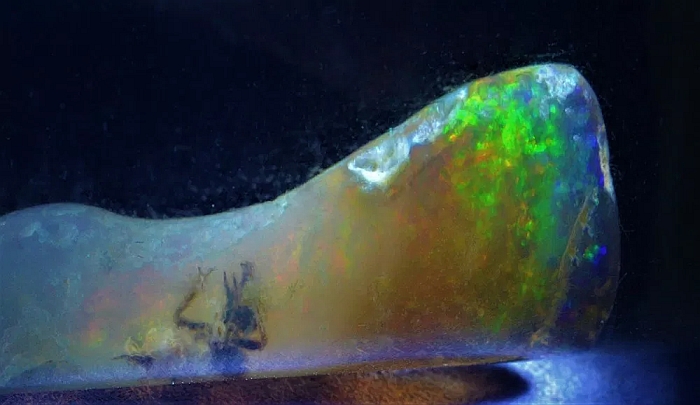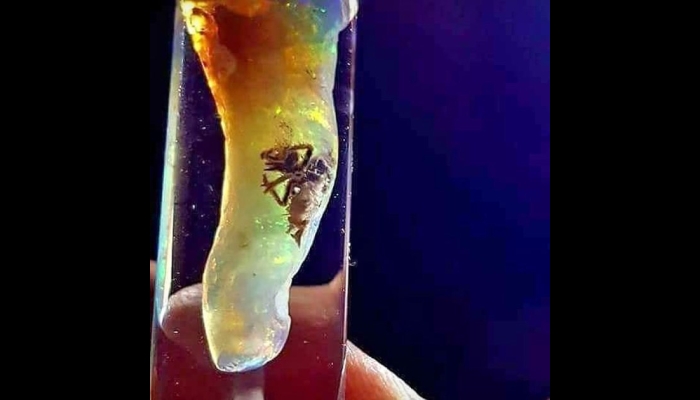Seemingly open mouthed, the insect was discovered, complete with fibrous structures extending from appendages.
Prized for its lush, fiery hues, amber has contributed quite tremendously to Earth’s fossil record as well.
“The petrified tree resin starts out as a viscous liquid, slowly hardening over million of years and preserving the entrapped remains of creatures that find themselves caught up in the process” – Vasika Udurawane, Earth Archives.
There have been some rather lively scenes captured in amber such as a spider attacking a wasp, an parasitic mite laying siege to an ant and a lizard seemingly floating mid air (or rather mid-amber).
Most scientists up until now believed that these high quality fossils were unique to amber alone, but a find intrigued gemologist Brian Berger – an opal is also very capable of preserving the remains of ancient species.
Berger went on to explain in a blog for Entomology Today hat he recently acquired an opal originating from Indonesia, the Island of Java to be exact. The stone was dotted with a rainbow of colors ranging from amber-esque shades of reds and yellows to dark blues and neon greens – quite impressive as is. However, what stood out was the insect entombed within, transforming the stone into a rather significant find in scientific discovery.
“You can see what appears to be a complete insect encased beautifully inside, Berger notes. “The insect appears to have an open mouth and to be very well preserved, with even fibrous structures extending from the appendages.”
There is the possibility that the bug was originally trapped in amber, going through a process known as opalization, similarly to how bone turns o stone through the process of fossilization.
Michelle Starr of Science Alert has mentioned that researchers are rather limited on the understanding of opal formation and that the current theory is that silica-laden water, which flows through sediment and cracks, filling them on its path. The water thereafter evaporates, leaving behind these silica deposits which start a repeat process until opal is finally formed.
Opal furthermore takes on an even more elaborate twist in Indonesia, the gem’s home. Volcanic fluid pours over the Earth, rather than just water, filling faults. As this fluid cools, the water within leaves behind silica deposits, jump-starting the considerable journey of opal formation.
It is however noteworthy that opalization seems to require a hollow cavity whereas amber does not seem to fit these parameters, leaving scientists rather baffled over how the opal piece, if originally amber even came to be.

Senior collection manager of Earth sciences at the South Australian Museum, Ben McHenry told Starr that the specimen in question might possibly share similarities with opalized wood, commonly occurring in Indonesia.
Ryan McKellar, curator of invertebrate palaeontology at the Royal Saskatchewan Museum in Canada has further gone on to add that Berger’s opal reminded him of a specimen featuring wood, partially embedded in resin. The section of wood that was covered in amber was preserved very similarly to a fossilized insect, but the exposed side had petrified.
Berger, moving forward hopes to recruit an entomologist or paleontologist which would be better equipped to study the unusual insect residing opal.

Starr has also noted that the stone has already been submitted to the Gemological Institute of America, reporting on the authenticity of the specimen as “unaltered, untampered precious opal, with a genuine insect inclusion.”
Berger, reflecting on the find’s potential with Starr concluded that “If the process of formation is correct, from tree sap with an insect through a sedimentary process, to copal, to amber, to opal it could mean the insect has the possibility to be one of the oldest ever discovered.”
My Name is Kasim Khan and I am the founder of Educate Inspire Change. I have just returned from a 1 week stay at the world’s first medically licensed plant medicine retreat, it’s called Rythmia and is in the beautiful country of Costa Rica. During this week I had the most profound and transformational experience of my life and it’s not only me . . .over 95% of people who embark on this journey at Rythmia reports that they too had a life changing miracle. This magical place had such a profound effect on me that I am now dedicating my time to sharing this healing opportunity of a lifetime with you all.
Please click HERE to find out more information and book yourself in for the most magical week of your life.
The post This Ancient Dead Bug Was Found Inside An Opal Rather Than Amber appeared first on Educate Inspire Change.